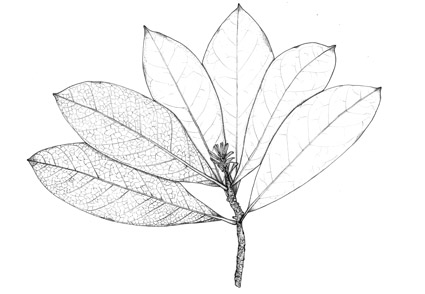Abstract
Paypayrola is a small genus of Violaceae consisting of small trees or shrubs found in the humid forests of South America. The boundaries between species have proven problematic, particularly among taxa in the Amazon. Through the analysis of Paypayrola specimens from this region, we have identified two new species, potentially restricted to campinarana vegetation. Paypayrola oppositifolia and P. pubiflora are distinguished from other known species in the genus by their phyllotaxy and the indumentum of reproductive parts. We provide morphological descriptions, illustrations, distribution maps, conservation status of the new species, and compare them with Amazonian species that are morphologically similar.
References
- Aublet, J.B.C.F. (1775) Histoire des plantes de la Guiane Françoise : rangées suivant la méthode sexuelle, avec plusieurs mémoires sur différens objects intéressans, relatifs à la culture & au commerce de la Guiane Françoise, & une notice des plantes de l’Isle-de France. P.F. Didot jeune, Londres. https://doi.org/10.5962/bhl.title.64646
- Aymard-C., G., Campbell, L.M. & Romero-González, G.A. (2014) Paypayrola arenacea (Violaceae), a new species with an unusual lifeform from a white sand Savanna in the Amazon River Basin of Venezuela. Harvard Papers in Botany 19: 175–184. https://doi.org/10.3100/hpib.v19iss2.2014.n2
- Bachman, S., Moat, J., Hill, A.W., de la Torre, J. & Scott, B. (2011) Supporting Red List threat assessments with GeoCAT: geospatial conservation assessment tool. ZooKeys 150: 117–126. https://doi.org/10.3897/zookeys.150.2109
- Ballard Jr., H.E., Paula Souza, J. & Wahlert, G.A. (2014) Violaceae. In: Kubitzki, K. (Ed.) The families and genera of vascular plants. Springer-Verlag, Berlin, Germany. pp. 303–322. https://doi.org/10.1007/978-3-642-39417-1_25
- Ballard Jr., H.E. (2022) A new Paypayrola (Violaceae) from Panama, with notes about the species complexes for the genus. Phytotaxa. 542 (3): 283–292. https://doi.org/10.11646/phytotaxa.542.3.4
- Beentje, H.J. (2010) The Kew Plant Glossary, an illustrated dictionary of plant terms. London: Royal Botanic Gardens Kew, 160 pp.
- Bentham, G. (1842) Schomburg’s Guiana plants [Capparidaceae to Tiliaceae]. Journal of botany: being a second series of the Botanical miscellany 4: 99–133
- Bisby, F.A. & Coddington, J. (1995) Biodiversity from a taxonomic and evolutionary perspective. In: Heywood, V.H. & Watson, R.T. (Eds.) Global Biodiversity Assessment. Cambridge University Press, Cambridge, pp. 27–56.
- Du Rietz, G.E. (1930) The fundamental units of biological taxonomy. Svensk Botanisk Tidskrift. 96 pp.
- Eichler, A.W. (1871) Violaceae. In: Martius, K.F.P., Eichler, A.W. & Urban, I. (Eds.) Flora Brasiliensis, vol. 13, part 1. Fleisher, Leipzig, pp. 345–396.
- Feng, M. (2005) Floral morphogenesis and molecular systematics of the family Violaceae. Ohio University, Ph. D. dissertation, Althens, 279 pp.
- Fernandes, A.G. (2006) Fitogeografia brasileira: províncias florísticas. Fortaleza, Brasil, 199 pp.
- GBIF (2023) Global Biodiversity Information Facility. Available from: https://www.gbif.org/ (accessed 30 November 2023).
- Hewson, H.J. (1988) Plant indumentum. A handbook of terminology. Australian Flora and Fauna Series 9. Canberra: Australian Government Publishing Service, 24 pp.
- Harris, J.G. & Harris, M.W. (2001) Plant identification terminology: An illustrated glossary. Spring Lake Publishing, Utah, 206 pp.
- Hekking, W.H.A. (1988) Violaceae. Part I–Rinorea and Rinoreocarpus. In: Flora Neotropica, Monograph 46. The New York Botanical Garden, New York, 207 pp.
- IBGE (2012) Manual Técnico da Vegetação Brasileira. Brasil. Rio de Janeiro. 274 pp.
- IUCN (2022) Guidelines for using the IUCN Red List categories and criteria. Version 12. Standards and Petitions Subcommittee of the IUCN Species Survival Commission. Published at http://www.iucnredlist. org/documents/RedListGuidelines.pdf (accessed 26 November 2023)
- de Jussieu, A.L. (1789) Genera plantarum : secundum ordines naturales disposita, juxta methodum in Horto regio parisiensi exaratam. Herissant et Theophilum Barrois, Paris, France.
- Melchior, H. (1925) Violaceae. In: Engler, H.G.A. & Prantl, K.A.E. (Eds.) Die natürlichen Pflanzenfamilien. Duncker and Humblot, Berlin, Germany. pp. 329–363.
- Munzinger, J.K. & Ballard, H.E. (2003) Hekkingia (Violaceae), a new arborescent violet genus from French Guiana, with a key to genera in the family. Systematic Botany 28: 345–351.
- Persoon, C.H. (1805) Synopsis plantarum, seu Enchiridium botanicum, complectens enumerationem systematicam specierum hucusque cognitarum. C.F. Cramer, Paris, France. https://doi.org/10.5962/bhl.title.638
- Pulle, A.A. (1912) Neue Beiträge zur Flora Surinams III. Recueil des travaux botaniques néerlandais 9: 125–168.
- Rodrigues, W.A. (1961) Aspectos fitossociológicos das caatingas do Rio Negro. Boletim do Museu Paraense Emílio Goeldi. Nova Série. Botânica, 15: 1–41.
- Sampaio, A.J. (1945) Fitografia do Brasil. São Paulo, Brasil, 372 pp.
- Scopoli, J.A. (1777) Introductio ad historiam naturalem sistens genera lapidum, plantarum, et animalium :hactenus detecta, caracteribus essentialibus donata, in tribus divisa, subinde ad leges naturae. Wolfgang Gerle, Pragae [Praha, Czech Republic]. https://doi.org/10.5962/bhl.title.10827
- Shorthouse, D.P. (2010) SimpleMappr, an online tool to produce publication-quality point maps. Available from: https://www.simplemappr (accessed 26 November 2023)
- Sprengel, C.[K.]. (1827) Caroli Linnaei, Systema vegetabilium. Librariae Dieterichianae, Gottingae [Göttingen, Germany].
- Thiers, B. (2023 [continuously updated]) Index herbariorum: a global directory of public herbaria and associated staff. New York Botanical Garden’s virtual herbarium. Available from: http://sweetgum.nybg.org/science/ih/ (accessed 26 January 2023)
- Tulasne, L.R. (1847) Flore de la Colombie-Plantes nouvelles [Samydeae to Violarieae]. Annales des Sciences Naturelles; Botanique, Série III 7: 360–373.
- Wahlert, G.A., Marcussen, T., Paula-Souza, J., Feng, M. & Ballard, H.E. (2014) A phylogeny of the Violaceae (Malpighiales) inferred from plastid DNA sequences: implications for generic diversity and intrafamilial classification. Systematic Botany 39: 239–252. https://doi.org/10.1600/036364414X678008


